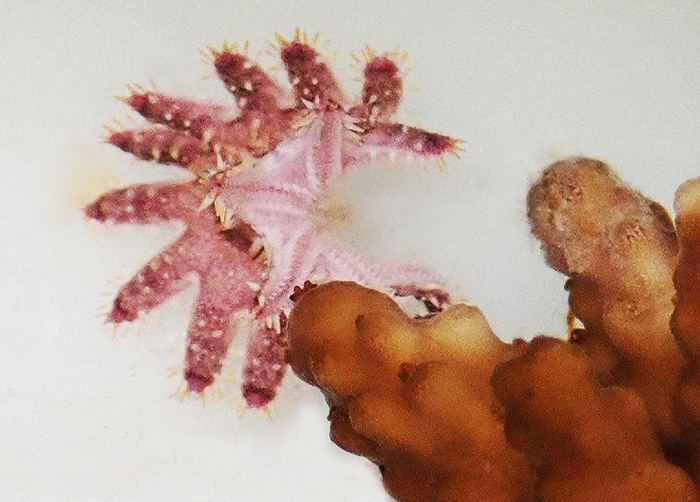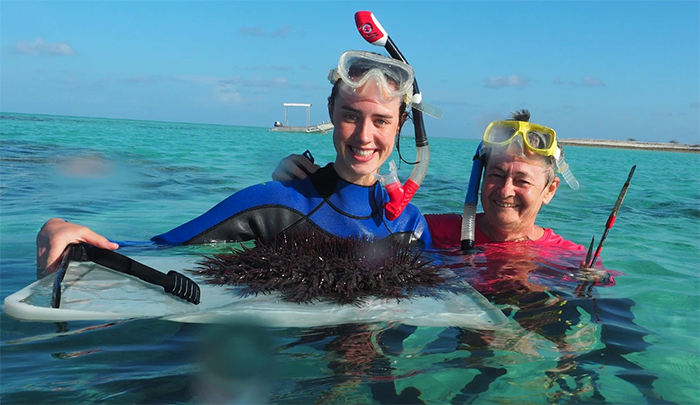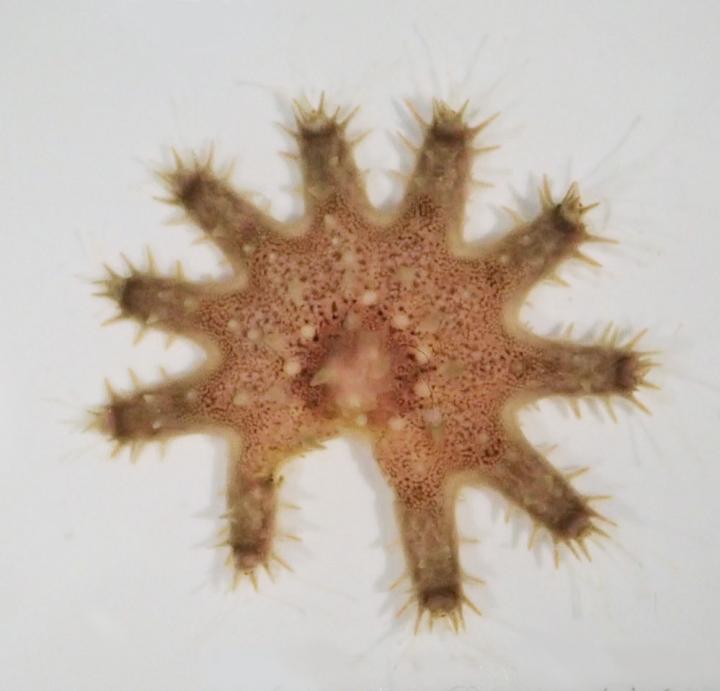
Coral can fight back against attacking juvenile Crown-of-Thorns starfish—using stinging cells to injure and even kill, showing that coral are not as passive as people may think. New research at by Australian scientists show that stony corals can fight back to inflict at times lethal damage. In many cases the sea stars were left with missing arms while some wounds proved lethal.
This microscopic mayhem occurs during a period of the Crown-of-Thorns starfish life cycle, where small juveniles shift from a vegetarian diet of algae to coral prey. But this change in diet makes the juveniles more vulnerable to attack by coral. Population outbreaks of adult Crown-of-Thorns starfish, alongside coral bleaching, are consider among the greatest threats to tropical reef habitats.
Video footage shows when the tube feet (small tube-like projections on the underside of a starfish’s arm used for movement) of juvenile Crown-of-Thorns starfish reaches out to touch the coral, the entire arm curls back to avoid the corals’ defensive weaponry. To protect themselves, coral polyps have stinging cells called nematocysts cells in their sweeper tentacles and outer tissue. Although invisible to the naked eye, these tiny projectiles can puncture soft tissue and deliver a dose of venom. Also called cnidocytes, these stinging organelles are also used by the coral to capture food.

Researchers Dione Decker (left, a doctoral candidate) and Professor Maria Byrne with an adult Crown-of-Thorns Starfish on the Great Barrier Reef. Credit: The University of Sydney.
An encounter with these nematocysts can damage the arms of juvenile Crown-of-Thorns starfish, delaying their growth into adulthood. Researchers also saw a 10 percent fatality rate among the coral-stung juvenile Crown-of-Thorns starfish they studied. However, most juveniles that survived arm damage were able to regenerate partially lost arms.
The research, published in Marine Ecology Progress Series, was led by Dione Deaker, a PhD student at the University of Sydney, and her supervisor Professor Maria Byrne. The marine scientists say that this is the first study of injury and regeneration in juvenile crown of thorn starfish following damage caused by natural enemies.
The researchers emphasize that the results may give a fascinating insight into coral behavior, but sting cells are not enough to protect coral from other threats such as human-caused climate change, overfishing, and water pollution.
Previous research led by Ms Deaker and Professor Byrne has shown juvenile starfish can survive on algae for more than six years when they were previously thought to change diets at four months old, lying in wait until there is an abundance of coral. Deaker says the period when young Crown-of-Thorns starfish shift from a vegetarian diet to eating coral, which is an animal, is a critical one. This is because young Crown-of-Thorns starfish who survive have the potential to contribute to population outbreaks that could devastate tropical reefs and coral.

In the study, researchers at the national Marine Science Centre, Coffs Harbour, monitored the condition, growth and survival of 37 juvenile Crown-of-Thorns in isolation from potential predators and reared them on a diet of coral prey for more than three months. They found coral stings caused injuries that severely reduced the arm length of the starfish by up to 83 percent.
The damage to the would-be predators was significant: 37.8 percent of juveniles were damaged by coral and four juveniles (10.8 percent) with severe injuries did not recover and died. The sting attacks from the coral also delayed the growth of juveniles, extending the time they need to maintain a vegetarian diet.
As show in the short video clip linked to below, the young starfish had a reflex response to being stung when they encountered coral. Their arms recoiled and twisted when their tube feet came into contact with the coral polyps.
“Sometimes the juveniles never recovered and died, but in most cases injured juveniles recovered and can regenerate their arms in about 4 months,” said Ms Deaker. “Despite being prey of Crown-of-Thorns starfish, coral can potentially influence the survival of juveniles and the appearance of a population outbreak on a reef by delaying their transition into an adult that can reproduce.”
Armed with these observations, the study shows that coral are a risky food choice for young Crown-of-Thorns starfish. Although coral injury was able to slow down the growth of the juvenile starfish, their ability to regenerate shows the resilience of this reef predator as a highly prolific species.
Professor Byrne said: “The importance of this study in showing the disconnect between size and age of the juveniles reinforces how challenging it is to understand the dynamics of adult population replenishment.”
VIDEO
University of Sydney researchers have witnessed juvenile crown of thorns starfish retreating after being stung by coral polyps. Credit: Dione Deake
—from materials released by the University of Sydney
References
Dione J. Deaker et al. The hidden army: corallivorous crown-of-thorns seastars can spend years as herbivorous juveniles, Biology Letters (2020). DOI: 10.1098/rsbl.2019.0849
DJ Deaker et al. Coral defences: the perilous transition of juvenile crown-of-thorns starfish to corallivory, Marine Ecology Progress Series (2021). DOI: 10.3354/meps13660





Hi I believe that a coral killing a starfish is not that unusual in my tank I have a healthy chalice coral that attacks small asterina starfish that fall off the glass and land on it they seem to disappear in a short amount of time and I never have seen any damage to the chalice.